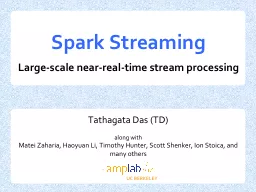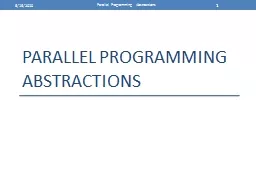PPT-Parallel Programming With Spark
Author : sherrill-nordquist | Published Date : 2016-07-17
Matei Zaharia UC Berkeley Fast expressive cluster computing system compatible with Apache Hadoop Works with any Hadoopsupported storage system HDFS S3 Avro Improves
Presentation Embed Code
Download Presentation
Download Presentation The PPT/PDF document "Parallel Programming With Spark" is the property of its rightful owner. Permission is granted to download and print the materials on this website for personal, non-commercial use only, and to display it on your personal computer provided you do not modify the materials and that you retain all copyright notices contained in the materials. By downloading content from our website, you accept the terms of this agreement.
Parallel Programming With Spark: Transcript
Download Rules Of Document
"Parallel Programming With Spark"The content belongs to its owner. You may download and print it for personal use, without modification, and keep all copyright notices. By downloading, you agree to these terms.
Related Documents











![[BEST]-Programming 11:C Programming Success in a Day & Rails Programming Professional](https://thumbs.docslides.com/980146/best-programming-11-c-programming-success-in-a-day-rails-programming-professional-made-easy-c-programming-c-programming-c-programming-language-rails-android-programming-ruby-rails-php-css.jpg)
![[PDF]-Programming 3: Python Programming Professional Made Easy & C Programming Success](https://thumbs.docslides.com/980147/pdf-programming-3-python-programming-professional-made-easy-c-programming-success-in-a-day-c-programming-c-programming-c-programming-language-html-python-programming-python-java-php.jpg)
